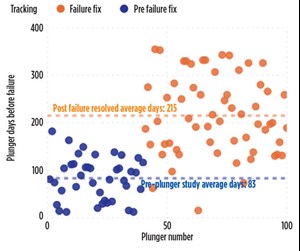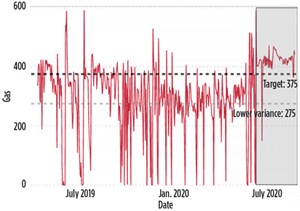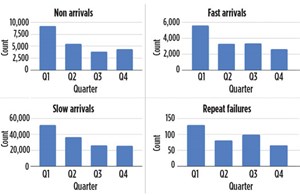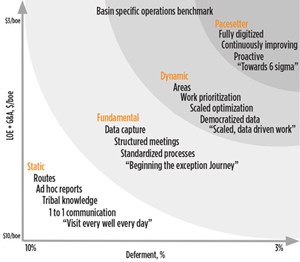Assessing production operations solves problems, increases well performance
Drilling is the revenue engine that drives upstream oil and gas growth. In this world, production operational priorities come second to drilling. At least, that was the case prior to the 2020 downturn. Now that drilling activity has subsided for a while—at least not to the levels seen in the past—the lifeblood of exploration and production (E&P) companies is producing wells. Consequently, E&P executives have shifted their attention more toward production operations, asking questions about well reliability, optimization, workflow efficiency and automation; but that shift has occurred only modestly.
The author will explain why E&P companies must move from a modest shift in operational focus to a much larger one, as well optimization and reliability have the biggest potential for improving margin performance over the coming years. Specifically, this article examines the state of production operations today; explores the role of advanced analytics in driving operational improvement; posits a well optimization framework and benchmark process that informs a digitalization roadmap; touches on how culture influences becoming a more data-driven organization; and outlines what E&P companies should do next.
Shift in focus to operations. The truth is sometimes a bitter pill to swallow. E&P executives are no different than others in this regard. The truth is that significant revenue and operating cost- savings are left on the table each day. This has occurred quietly for years, but growth from drilling has masked this reality. Unfortunately, many are unaware of this situation. In meeting with executives across mid-to-large-cap companies, statements like these were commonplace: “All of our wells are being optimized each day, even hourly;” “Our operators and engineers have the necessary tools and data to help them make informed, quick decisions;” “Our operations have best-in-class processes to ensure strategic goals are met, including production, reliability, and rig work.”
This is where perception and reality diverge. In its current state, well optimization involves scrolling through supervisory control and data acquisition (SCADA) well trends, hoping to catch with the naked eye behavior that does not meet past well performance. This activity happens across hundreds of wells per day by a single engineer. Following the identification of an anomaly, the engineer or operator focuses on 20 to 30 wells, reviewing information in disparate systems, including Excel, Spotfire, Power BI, SCADA, email and even texts to diagnose the problem. The engineer or operator then makes adjustments to the well—typically to the artificial lift system—leveraging heuristics and past experience with the intent of returning the well to normal production bounds. This process usually yields the following results: Anomaly detection–Anomalies remain undetected or missed until significant production declines occur, due to manual review, time constraints, and gradual anomaly production impacts; Optimization–Disparate data sources, more data than information, and time spent mostly fighting fires, and other duties hamper effective, scalable well optimization efforts; Predictive maintenance–Early warning signs often missed or do not present when manually inspected, leading to higher failure rates and deferred production volumes; Efficient workflows–Optimization duties assigned to a few engineers, which limits the quantity of wells optimized, or given to many, which limits quality of the optimization.
The reality is operators, optimizers and engineers have more work than they can handle in a given day, causing important tasks like anomaly detection and remediation to receive infrequent attention. Further, varying degrees of operational experience, inconsistent practices, and a lack of actionable information prevent timely situational awareness and prescriptive actions. E&P companies consequently fall short of achieving improved production volumes and lower operating costs.
Standard operational processes involve the review of select information to drive action. This can include daily work prioritization and root cause failure analysis, as well as artificial lift performance, repeat failures, and deferment reviews. These processes are where consistent business practices can make the difference in meeting an E&P company’s strategic goals.
The as-is state for these processes varies greatly. On one end of the spectrum, standard operations processes do not advance business goals around production. For instance, teams often do not review key metrics and trends related to mean time between failure or even leverage reporting capabilities to track failure trends. On the other end of the spectrum, teams have access to metrics and meet periodically, but rely on tribal knowledge versus data-driven decision-making. Reviewing, for instance, high-deferment wells daily, based on information in unstructured or verbal form can lead to suboptimal production outcomes. Optimizing production means relying on operational processes that are consistently applied, data-driven, and ultimately deterministic in outcomes. All too often, suboptimal well performance is due to process and technology inadequacies and not the engineers, themselves.
Best practice-driven operations processes drive positive well optimization outcomes that provide a feedback loop into continual process improvement. With operations as the new tip of the spear in driving margin, adopting best practices and creating an environment of continuous improvement is now more critical than ever. Getting there requires change and at the heart of that change is technology. To understand technology’s role, it is important to address resistance to change, how advanced analytics play a role in change, and what comes next.
Advanced analytics in operations. Vendors often frame their technology as a cure-all for most ills. The tendency for vendors to overpromise and under-deliver creates an atmosphere of doubt toward new technology initiatives.
All E&P companies understand that reliability in mechanical equipment is a constant challenge. They also would agree readily that better analytics, automation, and process standardization have the potential to improve reliability beyond the ability of today’s capacity-constrained, operations teams. The truth is that there is proven technology that has the impact needed by E&P companies. One reason these solutions are not widely deployed is that little time and resources are invested in integrating technology into operations workflows and existing processes. Any engineer who has traveled the digital oilfield path has encountered this integration gap. Such projects often lead to inefficiencies and unrealized value. This is not an argument for status quo, but one that suggests there are best practices in technology application that can lead to desired outcomes. Winston Churchill once said that “If you don’t take change by the hand, it will take you by the throat. I never worry about action, only inaction.” Technology when properly deployed, considers change management as a product feature or implementation phase that often continues beyond project closeout.
Benefits of leveraging analytics. Many industries have broadly applied advanced analytics statistics with great success. There is an equal opportunity for value in O&G operations. Technology research firm International Data Corporation (IDC) found in a study that analytics projects:1 Aimed at improving production had a median ROI of 277%; Involving financial management had a median ROI of 139%; Using predictive technologies had a median ROI of 145%, compared to 89% of projects without using predictive analytics.

After concluding a seven-year study of data from 864 respondents in nine countries and eight industries, Accenture, and Professor David Simchi-Levi at the Massachusetts Institute of Technology, in 2015 concluded that “the stronger a company’s commitment to analytics, the higher that company’s performance.”1 Piecing together the aforementioned statistics, it is clear that if E&P companies are seeking a competitive advantage, they can find it by applying analytics and technology to well optimization and operations processes, Table 1.
Advancing operations digitalization roadmap. Knowing where a company is today is critical to charting a course on where they go next. This is fundamental and necessary to advancing operations. There are many different directions that operations can choose to go; the question is which is the right one to reach strategic goals? Using Ambyint’s Well Optimization Assessment technology, the company’s engineering team can objectively determine the operational as-is state to identify the most valuable opportunities for improvement and provide a customized road map to fit the E&P’s business plan.
With access and insight into many operators’ processes and economics, Ambyint has identified the characteristics that lead E&P companies to outperform peers within the industry in terms of higher operating cash flow. Ideally, all E&P companies want to have the lowest $/BOE and deferment, but there is obviously something preventing them from achieving this.
There are many benefits in advancing beyond a lower performing or “static” operational phase, including reduced drive time and flaring, more effective work processes (workforce efficiency) and increased well reliability (production). The path to higher order phases for each company is different. As mentioned in the previous section, E&P companies must thoughtfully consider implementing proper change management against existing processes, preventing disruption that leads to inefficiencies. The subsequent benchmark was created from extensive analysis of 50 E&P companies. It gives Ambyint the ability to determine an E&P company’s operations performance versus industry peers. This is done within the context of a basin where companies face similar operating conditions.
The operations benchmark axes are lease operating expenses (LOE), plus general and administrative (G&A) divided by barrel oil equivalent, or LOE + G&A $/BOE and deferment percentage, Fig. 1. The Y axis shows operating costs and overhead necessary to produce a BOE. Midstream transportation and gathering costs are not included. The X axis is the deferment percentage generated from the field aggregation of well production versus target. These two axes, when compared at a basin level, put the E&P companies on a level playing field when benchmarking against one another. The phases of status, fundamental, dynamic, and pacesetter capture the characteristics that define each of the E&P companies’ distinct practices as they advance to lower $/BOE and deferment (upper right). There are many benefits to the E&P company as it moves away from a lower phase of operating, Static, to the highest phase, Pacesetter. The subsequent sections describe several of those benefits available to E&P companies.

Leveraging failure tracking in the fundamental phase. As a company reaches the “fundamental” phase of operations from “static,” it can leverage data capture to understand the as-is state. Once the firm understands its as-is state, it pinpoints areas needing improvement, works to improve operating practices in those areas, and communicates these lessons to the entire staff.
Figure 2 shows a plunger life visualization. Once plunger replacements and failure reasons were tracked, operations identified a poorly performing plunger (low plunger life days) amongst a common set of wells. They worked with other plunger vendors to bring in a new style of plunger to address failures and extend the plunger life. This increased well reliability, reduced site visits by operators, and increased month-over-month production.

Work prioritization in the dynamic phase. Companies that live in the “dynamic” phase of operations have established business practices, such as daily performance meetings to review outlier performers, and prioritize work to address anomalies. They use democratized data to find better ways to review wells and become proactive in preventing prolonged failures.
Once operators begin reviewing repeat failure wells, they identify wells that they continue to touch each week. Fig. 3. Leveraging their democratized data, they create standard meetings to review these wells and incorporate repeat failure wells into their daily work prioritization. Now, these wells avoid repeated failures for months, as anomalies are addressed as soon as they begin to trend.

Continuous improvement in the pacesetter phase. Companies that reach the “pacesetter” phase are continually improving what allows them to reach this phase—namely, business practices, work prioritization, and optimization. Leveraging digital or verbal communication for feedback, they create an environment of reviewing what is working, and fixing what is not. Improvement is a priority. The charts in Fig. 4 show an operation that has scaled optimization best practices across a large field of wells. There are still failures, but there is continued improvement to the work prioritization and optimization best practices that squeeze every bit of efficiency and reliability out of their wells and workforce.
Addressing cultural change. Digital, data-rich strategies and processes aren’t of much value unless the organization learns from the data and adopts new analytically driven behaviors and tactics. These are already second nature to digital startups, but often difficult for established firms to master. New Vantage Partners 2019 Big Data and AI Executive Survey found that cultural challenges remain the biggest obstacle to business adoption.2 Reasons for a lack of adoption of technology are: 40.3%–lack of organization alignment/agility; 23.6%–cultural resistance; 13.9%–understanding data as an asset; 7%–executive leadership; 5%–technology solutions. The study overwhelmingly found technology is not a blocker to companies becoming data-driven.2 The principal challenges to becoming data driven are: 62.5%–people; 30%–process; 7.5%–technology.
Operations faces even more challenges, as consultants and technology companies overwhelm them with “help.” Such help often meets resistance, due to a “not invented here” perspective. However, Ambyint understands how to align culture in a technology-oriented direction—specifically, top executives must have full buy-in, operations must understand its as-is state, and technology implementations must work intimately with the front line to solve their pain. Without these, E&P companies will find themselves on the bad side of these statistics. The company has extensive experience aligning executives with operational buy-in. They also have the well optimization assessment capabilities and tools to understand as-is state, and most importantly, to work intimately with the front-line personnel to understand their work and solve complex well production problems and issues.
What should you do to advance? Any E&P company focused on improved well performance is a prime candidate for an assessment–particularly E&P companies that struggle with visibility into optimization and operations process performance. Companies that feel they have crossed the optimization Rubicon also benefit. In fact, they should ask critical questions of internal staff around how they define and measure optimization outcomes as well as how those outcomes compare to industry leaders. Answers to those questions often highlight the need for a third-party assessment. For a small investment of time and resources, companies can quantitatively and objectively understand their state of operational performance, opportunities for improvement, and strategic direction. The Ambyint Well Optimization Assessment provides these insights. It is the best opportunity for establishing an operational roadmap for margin improvement on producing wells.
REFERENCES
- Harris, J. G., “Competing on analytics: updated, with a new introduction,” Harvard Business Review Press.
- New Vantage Partners LLC., “Big data and AI executive survey 2019.”

- Transforming challenging well production through advanced engineering (December 2025)
- Oil and gas in the capitals: Norway sustains the industry (December 2025)
- Industrial Intelligence: At Weatherford, data drives the bit and everything after (October 2025)
- CygNet enters a new chapter of evolution (September 2025)
- Overcoming extreme challenges: Advanced chemical solutions for offshore oil production integrity (September 2025)
- How AI can close the digital delta and transform legacy oil and gas operations (September 2025)
- Subsea technology- Corrosion monitoring: From failure to success (February 2024)
- Applying ultra-deep LWD resistivity technology successfully in a SAGD operation (May 2019)
- Adoption of wireless intelligent completions advances (May 2019)
- Majors double down as takeaway crunch eases (April 2019)
- What’s new in well logging and formation evaluation (April 2019)
- Qualification of a 20,000-psi subsea BOP: A collaborative approach (February 2019)



